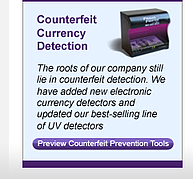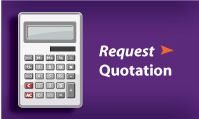
Here are three easy steps you can take, right now, with no cost and very little time investment to help your employees learn how to better detect fake money:
- Order or download the Department of Treasury's Multi-note booklet and poster to learn how to detect counterfeit money by memorizing the security features on the $5, $10, $20 and new $100 dollar bill. Their are free versions for download and larger, full color, posters and booklets you can order. Keep them in a conspicuous place in the back room to reinforce the training.
- Have every employee view each of the denominations in front of you and ask them to identify at least three security features on each bill. This simple exercise will give you the opportunity to point out other security features they may not be aware of and to reinforce their knowledge of the features they do recognize.
- Instruct your people that handling money is about paying attention. Practice with the employee by handing them some bills in combination such as 2 $20's, a $10 and a few $1s and ask them to organize the money according to denomination. Next, ask them to "face" the bills. Facing currency means turning every bill face up and pointing in the same direction (i.e. standing at the register, make sure every president faces the door or window of your store). By facing the bills, you're asking the employee to view each bill and determine its denomination.
Be aware that proper cash handling is the first step in how to detect counterfeit money. With proper cash handling techniques coupled with knowledge of the security features, your employees will be an asset on the front line of detecting counterfeit money.
Here Two Important "DON'TS".
- Don't rely on a counterfeit pen to identify fake $100 or $50 dollar bills. These pens only detect the presence of the starch used in copy or laser printer paper. Regular currency uses cotton based fibers. Although these pens will detect fake paper, it won't detect counterfeit money that is printed on cotton based paper. Secret Service Washed Notes Warning
- Don't assume your employees, even experienced employees, know the security features. Take time to teach them. Henry Ford once said, the only thing worse than training an employee and having them leave, is not training them and having them stay.
How To Detect Counterfeit Money - Technology

If you handle large amounts of cash, consider investing in affordable anti-counterfeiting technology. UV detectors and electronic money counters are simple and economical ways to take the guess work out of detecting counterfeit money.
UV detectors reveal the Ultra Violet security features built into most modern currency. Simply place the bill in the detector and view the readout. There are counter top and portable devices available.
Once you have taking the time to train your employees how to detect counterfeit money, teach them what to do when they receive or suspect they have received counterfeit money. The secret service is charged with protecting U.S. currency and tracking down counterfeiters. If your employee does suspect she may have received some counterfeit money, have them call your local police. Counterfeiting is a crime and the police will assist you.
Learning how to detect counterfeit money and teaching the preceding the few guidelines in this post will go a long way toward making sure your employees are prepared to handle cash appropriately and it will reduce or eliminate counterfeit money passing your counter.



